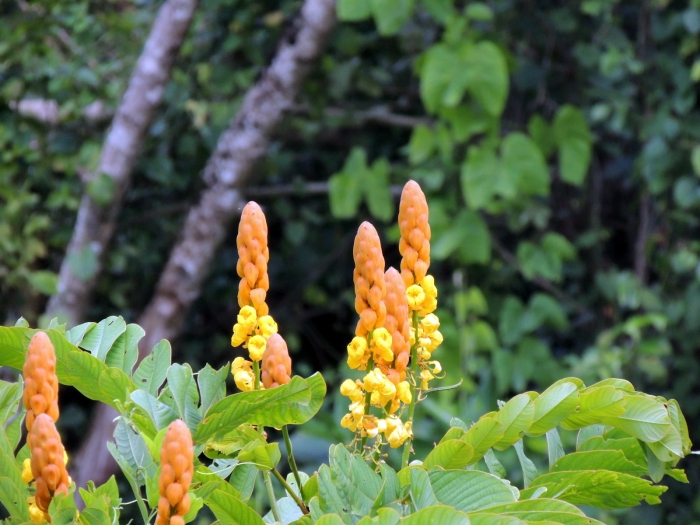Emperor’s Candlesticks
(Senna alata)
Emperor’s Candlesticks (Senna alata)
/
/

Vijay Barve
CC BY 4.0
Image By:
Vijay Barve
Recorded By:
Copyright:
CC BY 4.0
Copyright Notice:
Photo by: Vijay Barve | License Type: CC BY 4.0 | License URL: http://creativecommons.org/licenses/by/4.0/ | Rights Holder: Vijay Barve | Publisher: iNaturalist | Date Created: 2019-11-13T07:31-08:00 |











Estimated Native Range
Summary
Senna alata, commonly known as Emperor’s Candlesticks or Candle Bush, is a perennial shrub native to tropical regions of the Americas, including Mexico, Central America, and South America down to Paraguay. It is typically found in disturbed areas, secondary forests, and along forest margins where it can receive ample sunlight. This species can grow up to 13 feet tall and is characterized by its large, pinnate leaves that exhibit nyctinastic movements, closing at night. The plant is renowned for its striking yellow inflorescences, which resemble candlesticks and bloom throughout the year in its native habitat, making it quite showy.
Emperor’s Candlesticks is valued for its medicinal properties, particularly in treating skin diseases like ringworm and eczema, due to the presence of anthraquinones in its leaves. It is also used ornamentally in tropical and subtropical gardens for its unique floral display and as a privacy screen due to its height. It thrives in full sun and requires moderate watering, preferring well-drained soils. While it is relatively low-maintenance, it can be susceptible to pests like spider mites and mealybugs. In cultivation, it is important to manage its growth as it can become weedy and potentially invasive outside its native range, particularly in Austronesia. Gardeners should consult local regulations before planting to prevent ecological disruptions.CC BY-SA 4.0
Emperor’s Candlesticks is valued for its medicinal properties, particularly in treating skin diseases like ringworm and eczema, due to the presence of anthraquinones in its leaves. It is also used ornamentally in tropical and subtropical gardens for its unique floral display and as a privacy screen due to its height. It thrives in full sun and requires moderate watering, preferring well-drained soils. While it is relatively low-maintenance, it can be susceptible to pests like spider mites and mealybugs. In cultivation, it is important to manage its growth as it can become weedy and potentially invasive outside its native range, particularly in Austronesia. Gardeners should consult local regulations before planting to prevent ecological disruptions.CC BY-SA 4.0
Plant Description
- Plant Type: Shrub, Tree
- Height: 6-8 feet
- Width: 6-8 feet
- Growth Rate: Rapid
- Flower Color: Yellow
- Flowering Season: Summer
- Leaf Retention: Deciduous
Growth Requirements
- Sun: Full Sun, Part Shade
- Water: Medium
- Drainage: Medium
Common Uses
Border Plant, Butterfly Garden, Low Maintenance, Showy Flowers, Street Planting
Natural Habitat
Native to tropical regions of the Americas, found in disturbed areas, secondary forests, and along forest margins
Other Names
Common Names: Candle Bush , Ringworm Tree , Emperor’s Candlesticks , Bajagua , Café-Beirão , Candlestick Senna , Empress Candle Plant , Fedegoso-Gigante
Scientific Names: Senna alata , Cassia alata , Cassia alata subsp. perennis , Cassia alata subsp. rumphiana , Cassia alata var. perennis , Cassia alata var. rumphiana , Cassia arayatensis , Cassia bracteata , Cassia herpetica , Cassia rumphiana
GBIF Accepted Name: